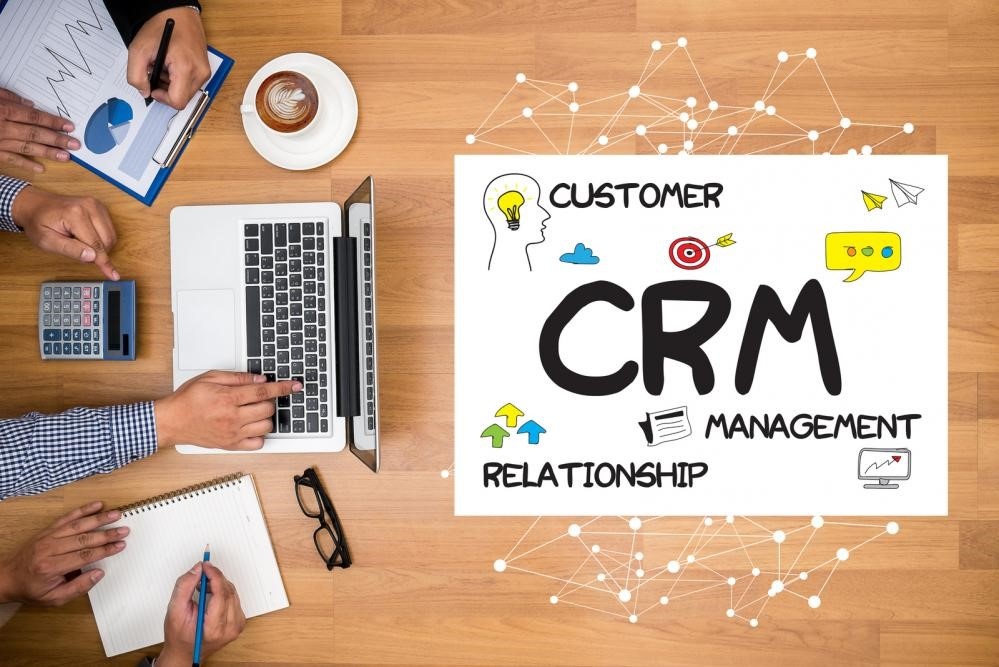Customer Relationship Management software (CRM) refers to business systems that have been designed to manage interactions between an organization and its customers or prospects. The benefits of this type of software are far-reaching. Utilizing proven CRM implementation steps can help ensure a successful integration that can do wonders for your business.
CRM systems streamline and centralize your customer data. As a result, they improve the quality of communication between your sales team and customers. This also provides much more visibility of sales activities and helps you achieve sustainable growth.
Following are 5 easy CRM implementation steps:
1. Assign a point person and build your team.
2. Define your goals and objectives.
3. Research software providers and select an application.
4. Develop an implementation plan.
5. Monitor and review your results.
However, before we go into too much detail, let’s dig into the basics a little.
Many people don’t fully understand how CRM systems work. Even if they do understand the fundamentals, introducing this type of system to an organization can be a mammoth task. Let’s take a look at what CRM is before looking at how you can implement it in your business.
What Is CRM Software?
Customer Relationship Management software is an application that’s purpose is to manage your company’s interaction with current and potential customers. It provides you with a simple user interface that is used to organize and manage your business contacts. This includes customers and prospects, but can also be used for partners, suppliers, employees, and other third parties.
The system stores all of the related information for these contacts in a centralized database. This database is continually updated to include the history of your interactions. This includes calls, emails, summaries of meetings, and the amount of revenue generated through each contact.
Additional Functions
In addition to contact management, CRM software can help you define and manage business processes. You can define workflows, manage your team, and measure your progress. Workflows can be automated and can be integrated with major business channels such as your website.
Read also: How An All-In-One Platform Can Run Your Whole Small Business
For example, suppose a prospect lodges an inquiry on your website. The CRM software can capture this inquiry and initiate a sales process. Then the sales process can be handled by someone on your staff, can be automated, or a combination of the two. The resulting process helps you deliver a prompt response, which can improve your rate of customer acquisition.
Common Customer Relationship Management Platforms
There are too many CRM applications available to list. However, there are quite a few that most people have probably heard of. These software packages collectively account for the majority of the CRM market, which reached $48.2 billion worldwide in 2018.
Salesforce
Salesforce is the market leader in CRM, with over $9.4 billion in 2018 revenue and a market share of 19.5%. Their branding efforts have been extremely successful, resulting in very high name recognition.
InfusionSoft
Infusionsoft was founded in 2001 and provides a platform designed for small businesses that have less than 25 employees. Features include email marketing, web tracking, lead scoring, and social media tools.
Zoho
Founded in 1996, the company was originally known as AdventNet. Zoho released the Zoho CRM application in 2005 and by mid-2008, had over 1 million users.
Software As A Service (SaaS)
The majority of CRM systems are provided as Software As A Service (SaaS). In a SaaS model, users don’t purchase a version of the software outright. Instead, the client licenses the software on a subscription basis. The vendor hosts the software on a centrally located server. This model is also commonly referred to as a “cloud-based” service.
Roughly 72.9% of spending on CRM software in 2018 was SaaS. Experts estimate that this number will grow in 2019 to approximately 75% of total spending.
Implementation Components
Successful CRM implementation is based on 3 primary components.
Technology
Technology is the core of your implementation. You should give careful consideration to all aspects of your integration:
- Is the application provided on a SaaS model or is it locally hosted?
- Are there any specific minimum equipment requirements necessary to run the application?
- What kind of support does the software company provide?
- What about backups, downtime, and security?
These are just a few of the questions that you should ask with any software implementation. (This post about ERP implementation may be helpful as well since ERP and CRM integrations have many shared components.)
People
Of course, since people are going to be using your new CRM, it’s important to consider how it will impact your team. As a result, you need to consider factors such as the usability and training requirements of the new system.
Software applications should make life easier for your staff, not harder.

Business Processes
For any software to work effectively, having established business processes is critical. Everyone has probably heard the phrase “garbage in, garbage out”. This is an appropriate description of how software applications work.
It doesn’t matter how good the CRM is. If you don’t have accurate data and your people don’t follow your processes, your results will be disappointing.
To successfully implement CRM software in your organization, you need to focus on all three components and their role in the system. It’s important to also remember that every organization is unique. You need an application that complements your business and manner of operations.
Finding a “perfect fit” for your needs may be difficult. If so, having a generic framework for implementing CRM can be a good starting point. While not ideal, you can optimize it later to suit your specific business requirements.
How To Implement CRM
5 Easy CRM Implementation Steps
Step 1: Assign a Point Person
Every project needs strong leadership to succeed. Your CRM implementation is no different. Your Project Manager (PM) should have a solid understanding of your business’s needs and processes.
You may not have someone internally with the skill sets to manage a project of this nature. If this is the case, then don’t worry. That’s not a show-stopper. Consider hiring an outside consultant to oversee and guide the implementation for you.
Implementing CRM software is a substantial amount of work. For this reason, you will most likely need to build a team to manage all the details. Your PM should be responsible for building and managing the team.
Communication
Your team should work collaboratively and good communication is a must. There are countless details that you need to consider and address. Make sure that your team is organized and thorough. If they aren’t, it’s likely that you will miss something.
Truth be told, on a project of this size, something will almost always get missed. You just want to make sure that any oversights are as inconsequential as possible.
File sharing tools and checklists are worth their weight in gold.
#ProTip
Step 2: Define Goals and Objective
The next step of the process is to analyze your current situation and define your goals. You need to decide what specific issues and processes you want your CRM to control, as well as your desired outcome.
Are you looking to solve existing problems? Is your goal simply to just increase your visibility of business activities? Whatever your reasons, make sure that you clearly understand what it is that you’re trying to accomplish. More importantly, make sure that implementing CRM software will achieve those goals.
You also need to make sure that you’re prepared to implement a software application of this magnitude. To do this, you’ll need to:
- Define your goals and objectives. Be sure that a CRM platform is going to be the solution that you need.
- Assess whether the organization has the resources to implement CRM. These include human, financial, technological, and process-oriented resources.
- Develop an implementation strategy.
- Establish and communicate CRM implementation as an organization-wide goal.
Step 3: Researching Vendors
Research the vendors that can provide you with CRM software. This involves the following:
- Analyzing the strengths and weaknesses of the vendor’s software
- Researching on the vendor’s experience in CRM systems
- Evaluating the level of support they provide to clients
- Asking for references

Make sure that you choose a CRM product that can complement the procedures currently in place and automate them.
Step 4: Develop Your Implementation Plan
Once you make the decision to implement a new platform, communicate it as an organizational objective and develop an implementation plan. The plan is where the rubber meets the road, so make sure you devote whatever resources are necessary to be thorough. Poor planning will come back to haunt you.
- Understand how all the users involved in the CRM process work. This means your sales, customer service, finance, marketing, and IT teams. It also involves your suppliers and partners. This will help you develop a CRM interface that can be readily adapted to your workflows.
- Provide training to your staff. No system will work well if your people don’t know how to use it. Don’t skimp here.
- Identify and make contingency plans for roadblocks and obstacles.
From a technological point of view, you must understand what goes into your customer relationship management procedures. You need to choose a system that complements your existing processes and procedures and can enhance them accordingly. This also involves engaging consumers, troubleshooting, and gathering data for each business contact.
Data Management and Integration
Optimize your CRM to gather the data both in terms of quantity and quality. This will help you assess the needs of your customers and improve accordingly.
It’s also important to integrate CRM processes across all channels of communication. For instance, your website is a valuable component in this regard. Aim for automation to enhance the productivity of your CRM system. This can also involve possible redesigns in your current processes to increase compatibility.
Step 5: Monitor and Review Results
The final step of implementing CRM involves measuring your success and recording the benefits. You can do this by answering the following questions:
- Were you able to realize all the objectives defined in your CRM strategy?
- Has your customer relationship management improved post-CRM implementation?
- How has CRM impacted your marketing performance?
- How has CRM contributed to the financial position of your company?
- What external factors have played a role in the success/failure of your CRM system?
- What were the biggest obstacles to implementing CRM?
After measuring the performance of your CRM implementation, you can re-assess the areas that require improvement. Identify gaps that need to be addressed with your review process. Monitor your results so you can continually refine your processes to get the most out of your investment.
Conclusion
Customer Relationship Management software is a valuable addition to just about any small business. However, the integration of these systems can be extremely challenging. As a result, utilizing proven CRM implementation steps can help ensure a successful integration that can do wonders for your business.


